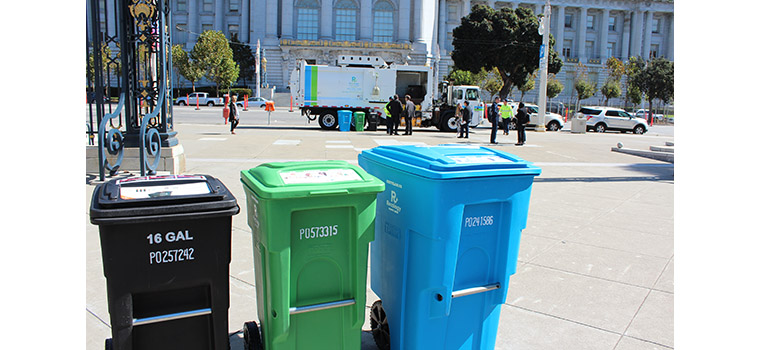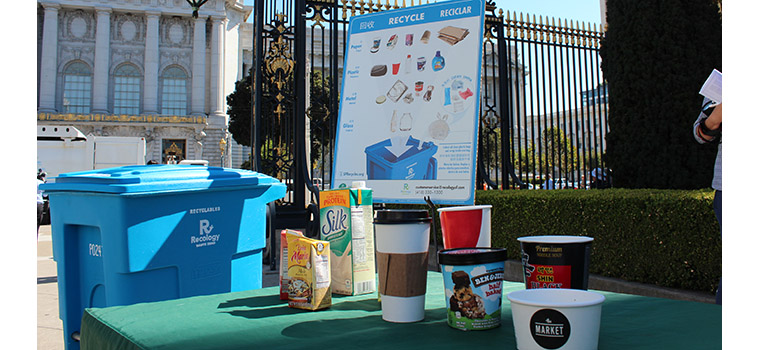It's been 17 years since San Francisco launched its highly successful recycling program, and many city residents admit they still find themselves wondering "do I or don't I?" when approaching the blue bin at their home or work.

People living in San Francisco can expect their black bins to get smaller and their blue bins to get bigger with the new expanded list of recyclable items accepted by Recology. SF Environment
BY BILL PICTURE
Published: November, 2017
It’s been 17 years since San Francisco launched its highly successful recycling program, and many city residents admit they still find themselves wondering “do I or don’t I?” when approaching the blue bin at their home or work.
San Francisco Department of the Environment (SF Environment) and Recology hope to make answering that question easier by expanding the list of recyclable items and taking more of the guesswork out of sorting waste. Effective immediately, to-go coffee cups with sleeves and lids, food cartons and plastic films (bags, shrink wrap and bubble wrap) can all be tossed in blue bin.
Technically, these bin-friendly items have been recyclable for some time, but the logistics involved with their collection, handling and processing made recycling on a citywide basis cost prohibitive until now. As a result, recycle-happy San Franciscans have had to begrudgingly chuck these items into their black bins with landfill-bound waste. But as technology has improved, Recology has seized the opportunity to keep more waste out of landfills and help San Francisco meet its goal of being a zero-waste city by 2020.
“There were operational challenges that needed to be addressed first, and Recology has made a tremendous invest-ment in upgrading their infrastructure at Recycle Central at Pier 96 in San Francisco,” said SF Environment spokesperson Peter Gallotta. “The expanded capacity and new technologies, such as optical sorters, have now enabled San Francisco to accept more recyclable materials in the blue bin.”
“It’s a serious investment in the city’s continuing commitment to achieve zero waste and our commitment to changing our industry into resource recovery,” said Recology’s Paul Giusti, the company’s community and government affairs manager.
The expansion of San Francisco’s recycling program is being rolled out on a neighborhood-by-neighborhood basis, beginning in the Sunset District and moving east toward the Bay, with all neighborhoods expected to be onboard with the program enhancements within the next two years. As neighborhoods join, business and residents will see their blue bins get bigger (64 gallons instead of 32 gallons), and their black bins get smaller (16 gallons instead of 32 gallons). Compost bins will remain the same size.
“The smaller black bins that are rolling out throughout San Francisco are intended to remind residents that very little material actually goes in the black bin,” said Gallotta. Roughly 50 percent of the waste deposited in black bins is actually recyclable or compostable, according to SF Environment.
“The blue and green bins are where the majority of items should be placed,” said Gallotta. So the real question that the new smaller black bins prompts residents to think about is, “Does it go in the blue or green bin?”
And the reminder appears to be working. Gallotta said that no sooner were bins swapped in the Sunset District than Recology reported an increase in the amount of waste being deposited in blue bins and a decrease in the amount being deposited in black bins. “These are very preliminary results, but are promising for the direction we want to be heading in,” he said.
In 2012, San Francisco reported an 80 percent diversion rate, meaning only 20 percent of the city’s waste was being sent to landfills. City officials hope its new recycling guidelines will help bump that diversion rate up to 90 percent. But to achieve zero waste, consumers will need to think more sustainably at the checkout counter—which means being more conscious about what they buy and how much, and about where those purchases are going to end up when they are done with them.
The onus is also on the manufacturers providing goods to consumers to design products more sustainably and think about the entire lifecycle of those products. And that can’t happen soon enough, as landfills are quickly nearing capacity. In 2013, SF Environment reported that only one million of the original 15 million tons contracted at Altamont Landfill were still available.
“While we have made tremendous progress toward reducing waste, we must keep up the momentum and try to do even more,” said San Francisco Board of Supervisors President London Breed at a press event last month. “The people of San Francisco are committed to zero waste, and these recycling changes represent another giant step forward in our history of environmental stewardship.”
“We are asking San Franciscans to join us, once again, in doing their part to help us reduce waste, reuse what they can, and recycle and compost even more,” said SF Environment Director Debbie Raphael.
Gallotta said that education is a key part of San Francisco’s zero-waste strategy, and SF Environment will be doing targeted outreach over the next few years to business owners, property managers and residents to inform them of program enhancements, along with providing new signage, bin stickers and other materials. A new website, SFRecycles.org, was also launched recently to be a one-stop resource that San Franciscans can use to figure out what goes in which bin.
“Success is dependent on everyone’s collective help,” Gallotta said.

City officials hope its new recycling guidelines will help get the City’s diversion rate up to 90 percent. SF Environment

